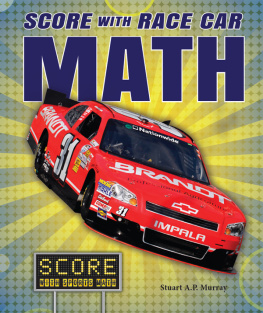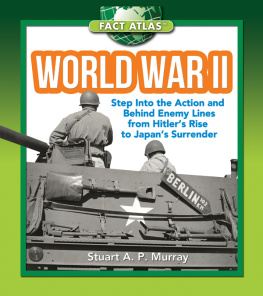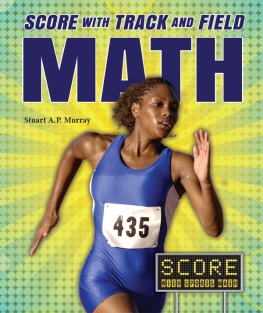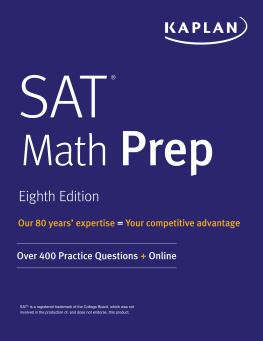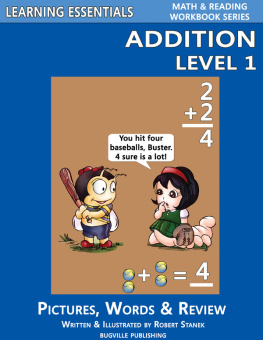Guess what? Lots of math is used in sports! How many points is a field goal? What percent of quarterback passes were intercepted? Even batting averages involve fractions and decimals. So get warmed up and ready to tackle some sports word problems, which include addition, multiplication, division, subtraction, fractions, and decimals. Learn some history and stats about your favorite athletes, too!
"Students often don't see the relevance of classroom math to their world. This series takes them into the exciting world of athletics, showing the direct relationship between the math the students are learning and various sports. Each book concludes with a fun chapter describing a competitive game, meet, or race in which the use of math enhances the excitement."
Carolyn Taylor, Series Math Consultant, Recipient of the Presidential Award for Excellence in Mathematics and Science Teaching
ABOUT THE AUTHOR
Stuart A.P. Murray is the author of more than forty books, a book editor, and a former journalist. He played soccer at Rutgers University and as a semi-pro, and has coached youth, high school, and college soccer. His latest fiction titles, Matty in the Goal and Todd Goes for the Goal, published by Enslow Publishers, Inc., are about youth soccer players.


Image Credit: Boomer544/Photos.com
A single-seat race car speeds along on a race track.
Ever since the first automobile, drivers have raced to see whose car is fastest. Even back in the 1800s, when the fastest cars were run by steam, drivers raced them. Steam was the same force that powered mighty train engines.
In the 1800s, steam automobiles were joined by gasoline-powered cars designed for use on roads. Both types were called horseless carriages. They were slower than four-horse stagecoaches or one-horse carriages. The power of the automobile was measured against the strength of horses. Early cars only had the power of three horses: three horsepower (hp). Automobiles improved in speed and power, but most roads were only dirt tracks. Driving on them was bumpy and slow. When cars broke down, people riding by in carriages laughed and shouted, Get a horse!
Automobile designs and engines developed rapidly. In the early twentieth century, most cars were large and heavy. They were meant for driving over rocky roads and through mud.
Most cars only went 35 to 40 miles an hour, but auto races were still exciting. Cars racing at the local horse track became a favorite event for people everywhere in America.

Image Credit: Wikimedia/Scientific American (1896)
"Horseless carriages" prepare for the start of a race in 1896.
Roads and race tracks improved, and "motoring" caught on around the world. Cars became faster and more comfortable. Buyers wanted the models that won the big races. Manufacturers could show off their vehicles in those races, so they organized more of them. Modern race tracks now had hard surfaces instead of dirt. Race cars became more powerful, until some went over 300 miles an hour. The strongest engines now had 700 horsepower. Auto racing was more thrilling than ever.
In this book, you'll learn some auto-racing facts and history, and you'll practice math, too. Knowing math makes auto racing even more exciting.
There are many types of auto racing. The most popular races are stock car, Formula One, and dragsters. Other races include dirt track, sport car, go-kart, pickup truck, and races by solar-powered and electric vehicles.
Some cars race around oval tracks a couple of miles long. Others zoom down short drag strips. Many race in rallies along winding roads and across hundreds of miles of rugged countryside. Auto racing is one of the worlds most popular sports, with the big races seen by millions of spectators in more than 200 countries.

Image Credit: U.S. Air Force photo by Larry McTighe
Stock cars at Daytona International Speedway.

Image Credit: Library of Congress Prints and Photographs Division, Washington, D.C. And Roberto Cerruti/Shutterstock.com
Top: A restored 1925 Bugatti race car competes in a long distance race in 2011. Bottom: Joe Dawson drives a National to win the 1912 Indianapolis 500.
By the early 1900s, inventors and mechanics around the world were building cars that were going faster and faster. In 1906, a steam-powered car rocketed along a Florida beach at more than 127 mph.
At first most races were more about going long distances than about speed. The longest car race ever was in 1908: 22,000 miles, from New York to Paris.
In 1909, the race that would become the Indianapolis 500 was first held before a crowd of 40,000 cheering fans. On oval-shaped tracks, speed was king.

Image Credit: Wikimedia/Holger Behr
In 1908, Americans driving the Thomas Flyer won the New York to Paris auto race in exactly 169 days. The Flyer first crossed the United States to the Pacific Ocean in 41 days, 8 hours, and 15 minutes. The journey continued by ship, then on land to Paris.
Q: After crossing the United States, how much longer did it take the Flyer to reach Paris? Round off to the nearest day.
A: Round off 41 days, 8 hours, and 15 minutes: 41 days Subtract 41 days from 169 days:
169 41 = 128 days
There were six teams: American, Italian, German, and three French. They fought sandstorms, blizzards, desert heat, mud, and breakdowns. Only three made it: the Americans, Italians, and Germans.

Image Credit: Library of Congress Prints and Photographs Division, Washington, D.C.
The cars in Times Square for the start of the race. The U.S. car is not in the picture.
Q: The Flyer arrived 26 days ahead of the second-place Italians. How many days did the Italians take?
A: Add 26 days to 169 days:
169 + 26 = 195 days
The Flyer left New York on February 12 at 11:15 in the morning and reached Paris on July 26 at 6:15 in the evening.
Q: What time was it in New York?
A: It took exactly 169 days, no hours or minutes, so in New York it was the same time as the race started: 11:15 in the morning.
The first cars had the power of three or four horses (hp). They could go only a few miles an hour (mph). Wisconsin offered $10,000 to builders of the first car that could go 5 mph for 200 miles. Modern cars have the power of hundreds of horses and can go more than 100 mph.
Q: An early car had a top speed of 5 mph. How fast is a modern car that is 30 times faster?
A: Multiply the early cars 5 mph by 30:
30 5 = 150
The modern car can go 150 mph.

